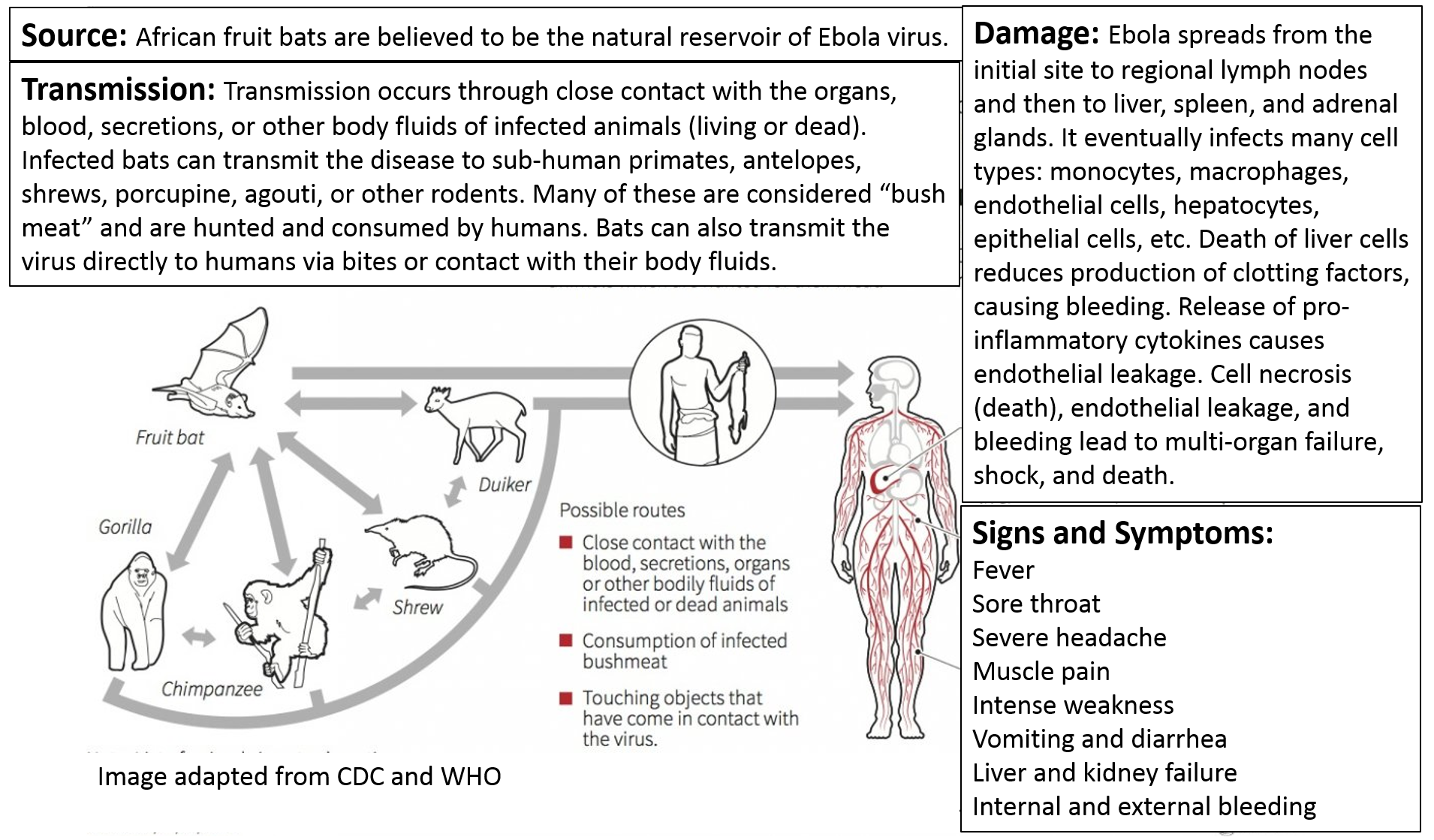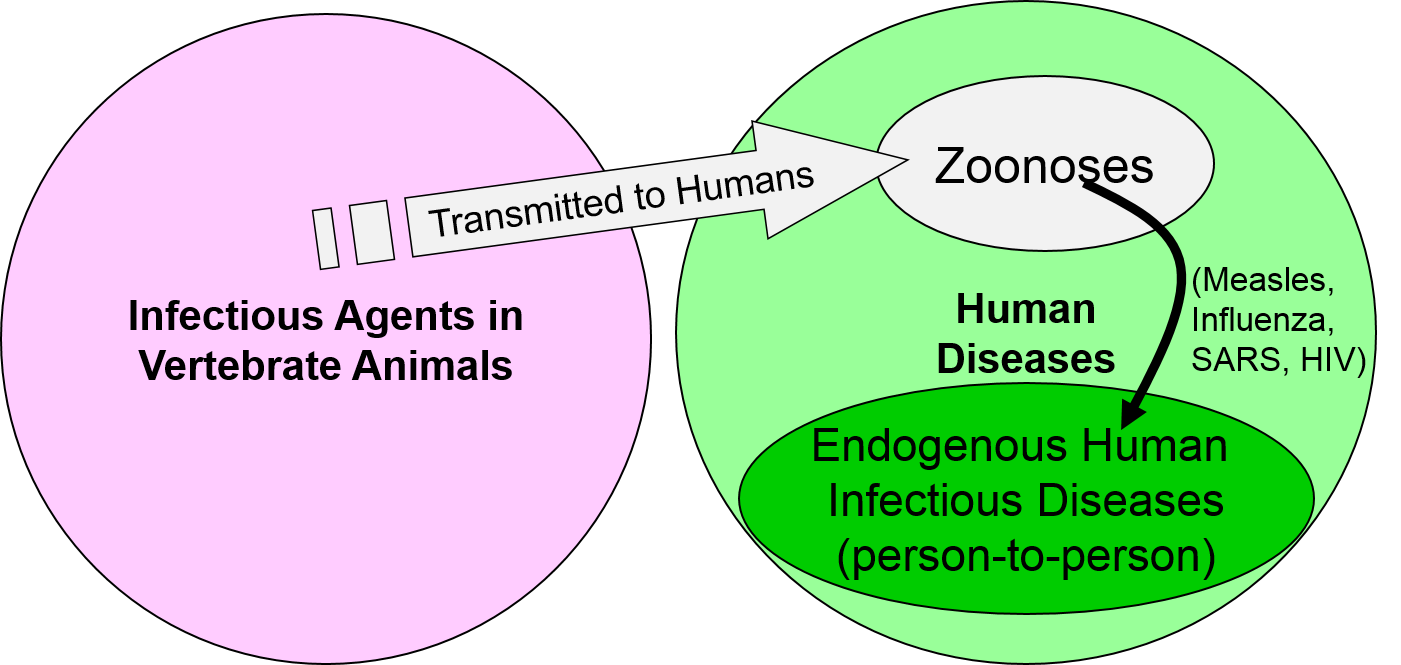Zoonoses
The CDC and WHO define zoonosis (or zoonotic disease) as any disease or infection that is naturally transmissible from vertebrate animals to humans. Zoonoses can be caused by bacteria, parasites, fungi, or viruses.
|
From CDC: How do you get zoonotic diseases? |
|---|
|
"People can get zoonotic diseases from contact with infected live poultry, rodents, reptiles, amphibians, insects, and other domestic and wild animals. A common way for these diseases to spread is through the bite of a mosquito or tick. People can get diseases in most places where they might have contact with infected animals and insects, including:
|
Consider the following examples.
Rabies
Rabies is a classic example of a zoonotic disease; an infected vertebrate (e.g., dog, bat, skunk, etc.) transmits the rabies virus to a human directly via a bite. In this case, the infected human does not transmit the disease to other humans (or animals). However, zoonotic transmission is not always limited to infection of a single human via a bite, because in many cases the disease is then transmitted from human to human
Some Vectorborne Disease
Rabies transmission to humans via an animal bite is a direct route, but zoonoses can also be transmitted from vertebrate animals to humans via vectors. Examples:
- Bubonic plague (Yersinia pestis): From rats or praire dogs to fleas to humans
- Lyme disease: From deer mice to ticks to humans
- West Nile virus: From birds to mosquitos to humans
Lyme disease and West Nile disease are not transmitted from human to human, but the pneumonic form of bubonic plague (plague infection in the lungs) can be transmitted from human to human via respiratory secretions.
Salmonellosis from Pets
We usually think of Salmonella infections being acquired from eating undercooked eggs or poultry that are contaminated. However, many species of Salmonella are commonly found in the environment, they can be found in the gastrointestinal tract of many animal species, including:
- Reptiles and Amphibians - Turtles, frogs, iguanas, snakes, geckos, horned toads, salamanders, and chameleons are often kept as pets, but they can carry Salmonella bacteria, and they have been responsible for many cases of human disease. For more information see "Reptiles, Amphibians, and Salmonella" at the CDC web site.
- Dogs and cats
- Rodents - See Swanson SJ, et al.: Multidrug-resistant Salmonella enterica serotype typhimurium associated with pet rodents. N. Engl. J. Med. 2007;356:21-8.
- Outbreaks of Salmonella in humans have also been linked to contaminated dry dog food.
Ebola
Ebola would also be considered a zoonotic disease. It is believed that certain species of fruit bats in Africa are the natural reservoirs for the Ebola virus. Close contact with the secretions, organs, or body fluids of living or dead bats can infect other animals, including sub-human primates, antelopes, shrews, porcupines, agouti, and other rodents, many of which are consumed as "bush meat" in Africa. Consequently, there are several possible routes by which Ebola can be transmitted from various vertebrate animals to man. In addition, once a human is infected, the virus can be transmitted from human to human via direct contact with blood, body fluids, or organs.
Ebola

Recommended precautions for preventing Ebola transmission from infected patients.
SARS
SARS is also considered a zoonotic disease. It is believed to have originated in Chinese horseshoe bats. The virus was then transmitted to civets, small cat-like mammals that are sometimes trapped and eaten in some parts of China. Humans may have first acquired SARS from civets through exposure to their blood or organs during butchering or food preparation. However, at some point the SARS virus became capable of being transmitted from human to human via respiratory secretions.
is also considered a zoonotic disease. It is believed to have originated in Chinese horseshoe bats. The virus was then transmitted to civets, small cat-like mammals that are sometimes trapped and eaten in some parts of China. Humans may have first acquired SARS from civets through exposure to their blood or organs during butchering or food preparation. However, at some point the SARS virus became capable of being transmitted from human to human via respiratory secretions.
Influenza
The influenza epidemics that affect us each year can also be considered zoonotic, since they originate in wild birds and are then transmitted to domestic fowl. The virus can then jump from domestic fowl to humans, or it can be transmitted from fowl to pigs, where genetic reassortment can take place before transmission to humans. Like SARS, once the virus has jumped to humans, it can be rapidly spread via respiratory secretions.
Prion Diseases
Variant Creutzfeldt-Jakob Disease (vCJD) is acquired by humans by eating beef or beef products contaminated with the abnormal prion proteins that cause bovine spongiform encephalopathy (BSE) in cattle. As a result, vCJD meets the criterion for a zoonotic disease.

Note, however, that vCJD can also be transmitted to humans via contaminated surgical instruments or during corneal transplantation; these routes of acquisition would be better classified as "common vehicle transmission."
Ancient Origins of Endogenous Human Disease
According to the CDC, "About 75% of recently emerging infectious diseases affecting humans are diseases of animal origin, and approximately 60% of all human pathogens are zoonotic."
As a result, many of the diseases that we now think of as distinctly human diseases, such as measles, smallpox, and diphtheria are believed to have originally jumped from animals to man.

We think of measles and smallpox as distinctly human diseases, particularly since there are no known animal reservoirs for either of them. However, it is believed that measles was originally a viral disease of dogs that was similar to the distemper virus that can afflict dogs and cats today. After jumping from dogs to humans, the virus mutated over many generations, and the mutations resulted in more efficient human to human transmission via respiratory secretions and also reduced severity of illness in humans. Today's version of the measles virus has changed sufficiently that it no longer infects dogs (although dogs still are at risk of distemper). Similarly, it is believed that smallpox was originally a cowpox virus that us jumped to humans and then mutated to a form that was distinct from cowpox.

Would malaria be considered to be a zoonotic disease?
Think before you check the answer.

